Party Time at the Raffles
The National Library’s collection of menu cards from Raffles Hotel provides an inkling of lavish parties and fine dining from bygone days. Francis Dorai and Jessie Yak take a peek.
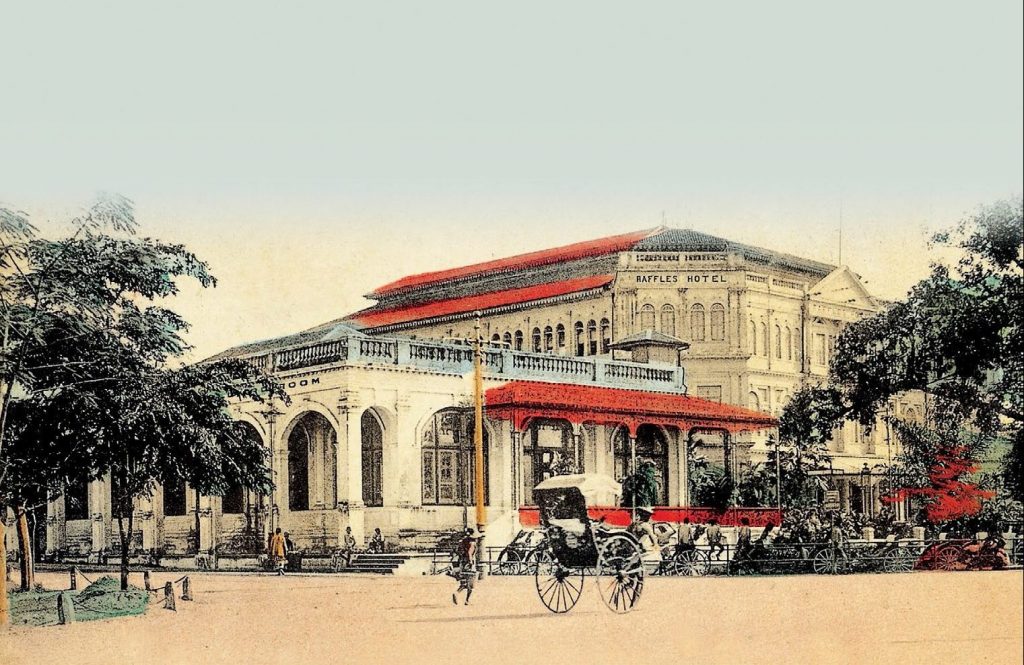 Postcard view of the Raffles Hotel, c. 1900. Courtesy of Professor Cheah Jin Seng and the Singapore Philatelic Museum.
Postcard view of the Raffles Hotel, c. 1900. Courtesy of Professor Cheah Jin Seng and the Singapore Philatelic Museum.The Raffles Hotel – which opened in 1887 with only 10 rooms – experienced its golden age during the first few decades of the 1900s. Immortalised in the writings of Joseph Conrad and Rudyard Kipling, the hotel soon became the lodgings of choice among wealthy travellers, celebrities and the literati, and even members of royalty.
With two extensions added in 1890, the Palm Court Wing in 1894, the now familiar grand Main Building in 1899, and the Bras Basah Wing in 1904, no other hotel in Singapore could rival the Raffles for its luxurious rooms and dining options.
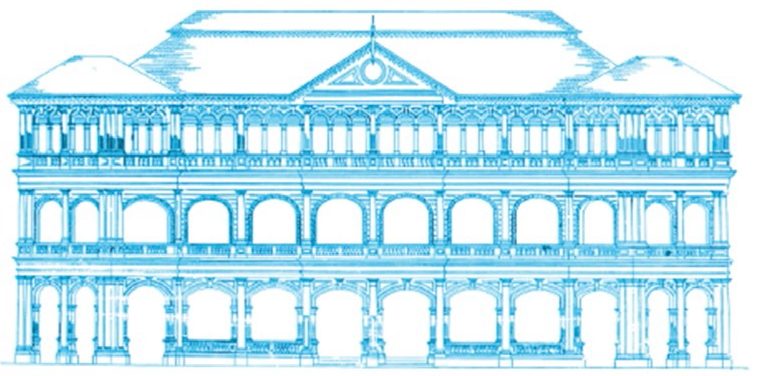 Drawing of the façade of the Main Building. This most recognisable extension of the Raffles Hotel was completed in 1899. All rights reserved. Liu, G. (2006). Raffles Hotel. Singapore: Editions Didier Millet.
Drawing of the façade of the Main Building. This most recognisable extension of the Raffles Hotel was completed in 1899. All rights reserved. Liu, G. (2006). Raffles Hotel. Singapore: Editions Didier Millet.The Raffles became a gathering place for the island’s rich and influential – the place to see and to be seen at – hosting lavish gala dinners for events like birthdays, race days, weddings, anniversaries, debutante balls, and even the coronations of European royal families.
One of the things the Raffles Hotel excelled at was throwing a good party. The devil, as they say, is in the details, and this is where the Raffles shone: its army of well-trained staff would leave no plate empty and no glass unfilled in their bid to ensure that every guest left a party plastered, if not with drink, then at least with a wide smile on their faces.
The opening of the Main Building at the turn of the 20th century properly entrenched the Raffles as the venue to host a fine party. The new marble-floored Dining Room “capable of seating 500”1 was where many indulgent dinners – supervised by two French chefs – would be served by white-gloved waiters.
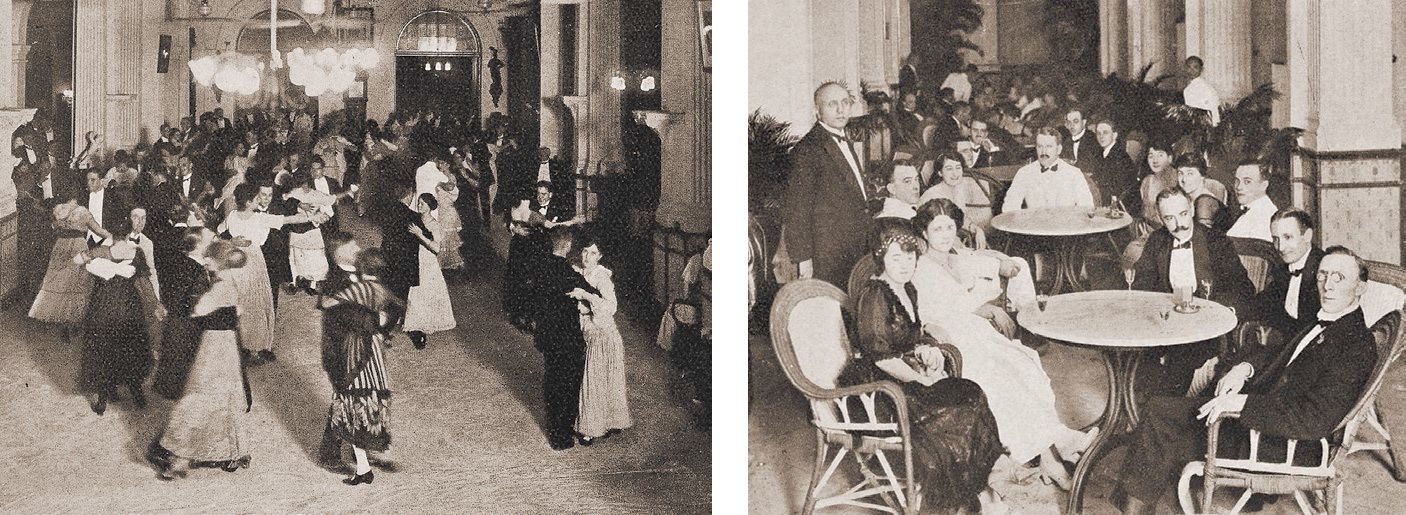 Scenes of the lavish Dining Room that was “capable of seating 500”. The spacious Dining Room on the ground floor of the new Main Building, which was declared opened in November 1899, was where many extravagant dinners and parties were held. All rights reserved. Liu, G. (2006). Raffles Hotel. Singapore: Editions Didier Millet.
Scenes of the lavish Dining Room that was “capable of seating 500”. The spacious Dining Room on the ground floor of the new Main Building, which was declared opened in November 1899, was where many extravagant dinners and parties were held. All rights reserved. Liu, G. (2006). Raffles Hotel. Singapore: Editions Didier Millet.Menu cards from this period, such as the one on 14 July 1917, featured gastronomic fare such as “Clear Turtle Soup, Baked Red Fish [in] Butter Sauce, Chicken en Aspic, Grilled Filet Steak & Sugar Peas, Faisan Roti [roasted pheasant] a l’ Anglaise, Iced Asparagus [in] Mayonaise Sauce… [and] Wild Rose Ice Cream…”, among other delights. At the outdoor Palm Court, after-dinner music would be played by the Band of the K.O.R (King’s Own Regiment).
In 1904, the Raffles introduced a novel form of entertainment – the Skating Dinner. To the accompaniment of a live orchestra, grown men and women put on roller skates supplied by the hotel and “… skated about with the utmost glee until 11 o’clock when the fun had to stop despite the great anxiety of the guests to prolong the rinking”.2
German author Hermann Hesse was clearly not amused by the noise emanating from such a party on the night he spent at the Raffles. He recorded in his diary dated 29 October 1911: “the gigantic hotel is horrible acoustically and echoes like a drum in its vast corridors and stairways”.3
In the heady days before World War II, tickets for the legendary New Year’s Fancy Dress Ball would be booked out weeks in advance. The first such party was held on 1 January 1911 and was reported to be a resounding success by the press. The guest list was invariably European with the occasional moneyed Peranakan or Chinese making an appearance.
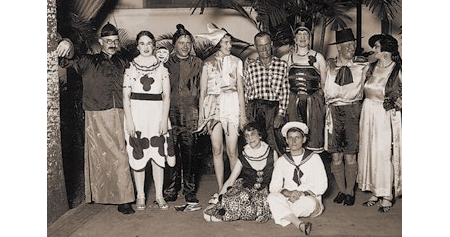 Revellers all dressed up at a New Year’s Fancy Dress Ball at the Raffles Hotel, c. 1930s. All rights reserved. Liu, G. (2006). Raffles Hotel. Singapore: Editions Didier Millet.
Revellers all dressed up at a New Year’s Fancy Dress Ball at the Raffles Hotel, c. 1930s. All rights reserved. Liu, G. (2006). Raffles Hotel. Singapore: Editions Didier Millet.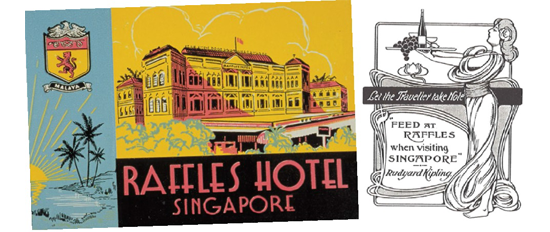 (Left) Postcard of Raffles Hotel from the 1950s. Courtesy of the Raffles Hotel and National Museum of Singapore, National Heritage Board.
(Left) Postcard of Raffles Hotel from the 1950s. Courtesy of the Raffles Hotel and National Museum of Singapore, National Heritage Board.The opening of the capacious grand ballroom in 1921 further heightened the attraction of the Raffles Hotel. Lively tea dances from 5 to 7pm, and regular dance evenings and concerts became the mainstay of the social calendar, with music provided by the Raffles Hotel Orchestra under the baton of musical director F.A. Cooke.
The ballroom also added to the continuing popularity of the New Year’s Fancy Dress Ball, which remained a fixture until World War II. Now there was a proper place to show off the quickstep and foxtrot after the stroke of midnight, the dance floor only slightly overshadowed by the outrageous costumes revelers would turn up in.
The party atmosphere at the Raffles was clearly contagious, as British traveller Beatrice Borland observed during her stay at the hotel in 1933: “The truth of the matter is, it is impossible to lead a simple life at the Raffles Hotel, so you might as well join in the all-pervading air of wicked gaiety.”4
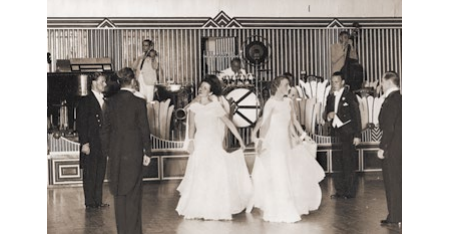 The capacious Raffles Hotel ballroom which opened in 1921 – said to be the largest in Asia at the time − was where dance evenings, concerts and musical shows took place. All rights reserved. Liu, G. (2006). Raffles Hotel. Singapore: Editions Didier Millet.
The capacious Raffles Hotel ballroom which opened in 1921 – said to be the largest in Asia at the time − was where dance evenings, concerts and musical shows took place. All rights reserved. Liu, G. (2006). Raffles Hotel. Singapore: Editions Didier Millet.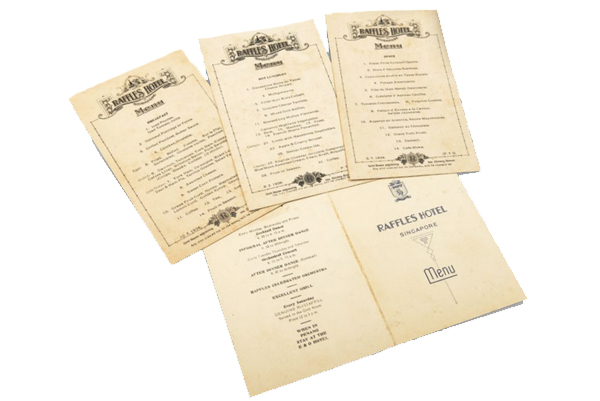 A selection of Raffles Hotel menu cards from the 1930s. From left, sumptuous offerings for breakfast (10 July 1934), lunch (8 February 1936) and dinner (5 July 1934). On the back of the 17 September 1936 menu card is the entertainment programme for the evening. Cocktail dances were held on Monday, Wednesday and Friday evenings, while the Orchestral Concerts took over on Tuesday, Thursday and Saturday. On all six evenings, after dinner dances took place at the grand ballroom until midnight (Sunday was presumably a quiet day at the Raffles!) By 1931, the hotel had fallen on hard times as a series of poor business decisions by its Armenian owners, the Sarkies brothers, had left the Raffles saddled in debt. Looking at these lavish menu cards, however, it is difficult to imagine the financial difficulties the hotel was mired in.
A selection of Raffles Hotel menu cards from the 1930s. From left, sumptuous offerings for breakfast (10 July 1934), lunch (8 February 1936) and dinner (5 July 1934). On the back of the 17 September 1936 menu card is the entertainment programme for the evening. Cocktail dances were held on Monday, Wednesday and Friday evenings, while the Orchestral Concerts took over on Tuesday, Thursday and Saturday. On all six evenings, after dinner dances took place at the grand ballroom until midnight (Sunday was presumably a quiet day at the Raffles!) By 1931, the hotel had fallen on hard times as a series of poor business decisions by its Armenian owners, the Sarkies brothers, had left the Raffles saddled in debt. Looking at these lavish menu cards, however, it is difficult to imagine the financial difficulties the hotel was mired in.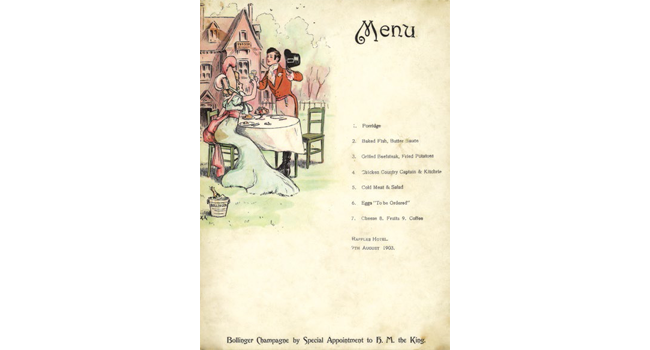 In comparison, the breakfast menu offerings some 30 years earlier on 9 August 1903 were decidedly more spartan.
In comparison, the breakfast menu offerings some 30 years earlier on 9 August 1903 were decidedly more spartan.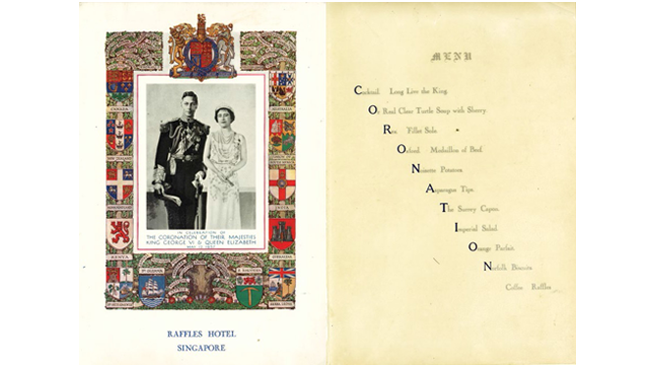 In comparison, the breakfast menu offerings some 30 years earlier on 9 August 1903 were decidedly more spartan.
In comparison, the breakfast menu offerings some 30 years earlier on 9 August 1903 were decidedly more spartan.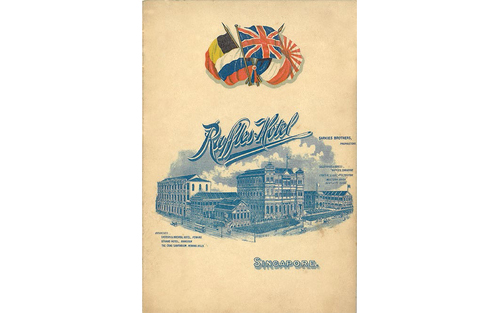 According to the book Raffles Hotel by Gretchen Liu, this menu was created for a dinner held in honour of Song Ong Siang, a Queen’s Scholar and author of the book One Hundred Years’ History of the Chinese in Singapore.
According to the book Raffles Hotel by Gretchen Liu, this menu was created for a dinner held in honour of Song Ong Siang, a Queen’s Scholar and author of the book One Hundred Years’ History of the Chinese in Singapore.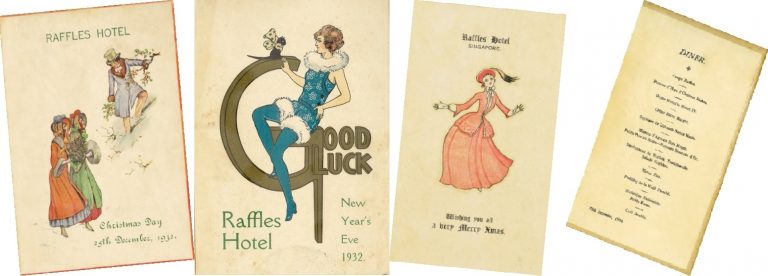 Festive menu covers from Christmas and New Year’s Eve dinners in 1932, and Christmas 1936. French fare was served for dinner on Christmas Day 1936.
Festive menu covers from Christmas and New Year’s Eve dinners in 1932, and Christmas 1936. French fare was served for dinner on Christmas Day 1936.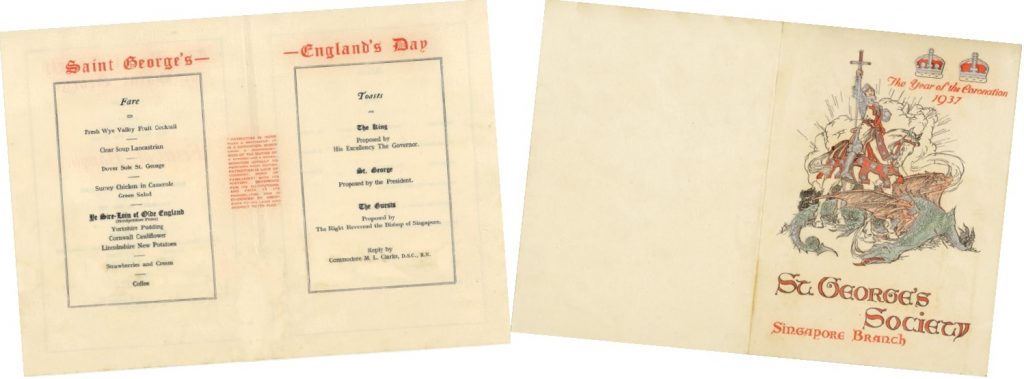 The Royal Society of St George was founded in 1894 with the aim of promoting “Englishness” and the English way of life in countries wherever the British had settled. The Singapore branch was founded in 1925. Sir Lawrence Guillemard, then Governor of the Straits Settlements, became a patron and life member of the society. Pictured here is the celebratory menu and programme for the society’s “England Day” menu on 6 May 1937.
The Royal Society of St George was founded in 1894 with the aim of promoting “Englishness” and the English way of life in countries wherever the British had settled. The Singapore branch was founded in 1925. Sir Lawrence Guillemard, then Governor of the Straits Settlements, became a patron and life member of the society. Pictured here is the celebratory menu and programme for the society’s “England Day” menu on 6 May 1937.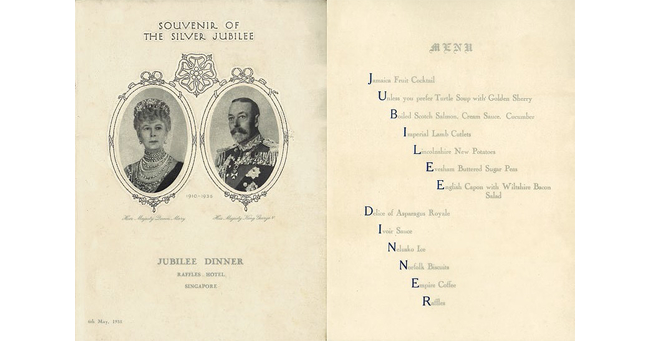 The menu card of the Jubilee Dinner held on 6 May 1935 to celebrate the 25th anniversary of the coronation of King George V and Queen Mary. Whoever crafted this menu to spell out the words “Jubilee Dinner” must have really struggled to come up with the appropriate dishes. The letter “U” for “Unless you prefer turtle soup with golden sherry” is rather lame and one wonders what inventive dessert dish called “Raffles” the chef had concocted for the letter “R”!
The menu card of the Jubilee Dinner held on 6 May 1935 to celebrate the 25th anniversary of the coronation of King George V and Queen Mary. Whoever crafted this menu to spell out the words “Jubilee Dinner” must have really struggled to come up with the appropriate dishes. The letter “U” for “Unless you prefer turtle soup with golden sherry” is rather lame and one wonders what inventive dessert dish called “Raffles” the chef had concocted for the letter “R”!All the menus featured in this article were donated to the National Library, Singapore, by Roberto Pregarz, who was General Manager of Raffles Hotel from 1972 to 1989. He is a collector of historical memorabilia from the Raffles Hotel, and the author of two books: Memories of Raffles: 22 Years with a Grand Old Hotel and Raffles Legends and Stories.
These menus are part of the National Library’s Rare Materials Collection. The collection – which is kept in a climate controlled facility on level 13 of the National Library − comprises over 11,000 items, mostly books and periodicals, but also materials such as manuscripts, maps, photographs, art prints and illustrations, as well as handwritten letters and documents.
To provide access to the materials, the Rare Materials Collection is being digitised and made available on National Library’s BookSG website at National Library Online. Microfilm copies are also available at level 11 of the Lee Kong Chian Reference Library (Singapore & Southeast Asian Collection) at NLB Building. To view the originals, please email your request to ref@nlb.gov.sg.
 Francis Dorai has worked for over two decades in publishing, both as writer and editor in a broad range of media, including The Straits Times, Insight Guides, Berlitz Publishing, Pearson Professional, Financial Times Business and Editions Didier Millet. He is the author of several books, including "South Beach: From Sea to Sky: The Evolution of Beach Road".
Francis Dorai has worked for over two decades in publishing, both as writer and editor in a broad range of media, including The Straits Times, Insight Guides, Berlitz Publishing, Pearson Professional, Financial Times Business and Editions Didier Millet. He is the author of several books, including "South Beach: From Sea to Sky: The Evolution of Beach Road".
 Jessie Yak is a Reference Librarian with the Rare Collections team at the National Library, Singapore. She majored in Chinese language and literature at Beijing University and furthered her studies at the University of Cambridge. Jessie is interested in Chinese literature, the Chinese diaspora and the print culture of East Asia.
Jessie Yak is a Reference Librarian with the Rare Collections team at the National Library, Singapore. She majored in Chinese language and literature at Beijing University and furthered her studies at the University of Cambridge. Jessie is interested in Chinese literature, the Chinese diaspora and the print culture of East Asia.
Notes
-
Liu, G. (1999). Singapore: A pictorial history, 1819–2000 (p. 123). Singapore: National Heritage Board and Editions Didier Millet. Call no.: RSING 959.57 LIU-[HIS] ↩
-
Liu, G. (2006). Raffles Hotel (p. 49). Singapore: Editions Didier Millet. Call no.: RSING q915.9570613 LIU-[TRA] ↩

